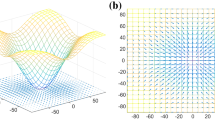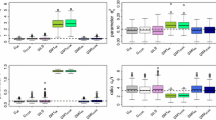Abstract
The elevations recorded within digital models are known to be fraught with errors of sampling, measurement and interpolation. Reporting of these errors according to spatial data standards makes several implicit and unacceptable assumptions about the error: it has no spatial distribution, and it is statistically stationary across a region, or even a nation. The approach explored in this paper employs actual elevations measured in ground and aerial survey at higher precision than the elevations in the DEM and recorded on standard paper maps. These high precision elevations are digitized and used to establish the real statistical and spatial distribution of the error. Direct measurements could also have been taken in the field by GPS or any other means of high precision data collection. These high precision elevations are subtracted from values stored in the DEM for approximately the same locations. The distribution of errors specific to the DEM can then be explored, and can be used in the geostatistical method of conditional stochastic simulation to derive alternative realizations of the error modeled and so of the DEM. Multiple versions of the derived products can also be determined. This paper compares the results of using different methods of error modeling. The best method, which gives widely implementable and defensible results, is that based on conditional stochastic simulation.
Similar content being viewed by others
References
T.J. Davis and C.P. Keller. “Modeling uncertainty in natural resource analysis using fuzzy sets and Monte Carlo simulation: slope stability prediction,” International Journal of Geographical Information Systems, Vol. 11:409–434, 1997.
C.V. Deutsch and A.G. Journel. GSLIB: Geostatistical Software Library and Users Guide, University Press: Oxford, 1992.
DCDSTF (Digital Cartographic Data Standards Task Force), “The proposed standard for digital cartographic data,” American Cartographer, Vol. 15:9–140, 1988.
A.A. Elassal and V.M. Caruso. “USGS Digital Cartographic Data Standards: Digital Elevation Models,” USGS Circular 895-B, Reston, Virginia, 1983.
E. Englund. “Spatial simulation: Environmental applications,” in M.F. Goodchild, B.Q. Parks and L.T. Steyaert (Eds.), Environmental Modeling and GIS, Oxford University Press: New York, 432–437, 1993.
P.F. Fisher. “First experiments in viewshed uncertainty: the accuracy of the viewable area,” Photogrammetric Engineering and Remote Sensing, Vol. 57:1321–1327, 1991.
P.F. Fisher. “Modeling soil map-unit inclusions by Monte Carlo simulation,” International Journal of Geographical Information Systems, Vol. 5:193–208, 1991.
P.F. Fisher. “First experiments in viewshed uncertainty: simulating the fuzzy viewshed,”Photogrammetric Engineering and Remote Sensing, Vol. 58:345–352, 1992.
P.F. Fisher. “Algorithm and implementation uncertainty in viewshed analysis,” International Journal of Geographical Information Systems, Vol. 7-4:331–374, 1993.
P.F. Fisher. “Probable and fuzzy models of the viewshed operation,” in M. Worboys (Ed.), Innovations in GIS 1, Taylor & Francis: London, 161–175, 1994
P.F. Fisher. “Reconsideration of the viewshed function in terrain modeling,” Geographical Systems, Vol. 3-1:33–58, 1996.
M.F. Goodchild. “Algorithm 9: Simulation of autocorrelation for aggregate data,” Environment and Planning A, Vol. 12:1073–1081, 1980.
M.F. Goodchild. Spatial Autocorrelation, CATMOG 47, GeoBooks: Norwich, 1986.
M.F. Goodchild. “Attribute Accuracy,” in S.C. Guptill and J. Morrison (Eds.), Elements of Spatial Data Quality, Oxford: Pergamon, 59–79, 1996.
M.F. Goodchild, S. Guoqing, and Y. Shiren. “Development and test of an error model for categorical data,” International Journal of Geographical Information Systems, Vol. 6:87–103, 1992.
M.F. Goodchild and G.J. Hunter. “A simple positional accuracy measure for linear features,” International Journal of Geographical Information Systems, Vol. 11:299–306, 1997.
P. Goovaerts. Geostatistics for Natural Resource Evaluation. University Press: Oxford, 1997.
G.J. Hunter and M.F. Goodchild. “Modeling the uncertainty of slope and aspect estimates derived from spatial databases” Geographical Analysis, Vol. 29-1:35–49, 1997.
R.E. Huss and M.A. Pumar. “Effect of database errors on intervisibility estimation,” Photogrammetric Engineering and Remote Sensing, Vol. 63:415–424, 1997.
A. Journel. “Modeling uncertainty and spatial dependence: Stochastic imaging,” International Journal of Geographical Information Systems, Vol. 10:517–522, 1996.
D.P. Lanter and H. Veregin. “A research paradigm for propagating error in layer-based GIS, ” Photogrammetric Engineering and Remote Sensing, Vol. 58:825–833, 1992.
J. Lee, P.K. Snyder, and P.F. Fisher. “Modeling the effect of data errors on feature extraction from digital elevation models,” Photogrammetric Engineering and Remote Sensing, Vol. 58-10:1461–1467, 1992.
Z. Li. “On the measure of digital terrain model accuracy,” Photogrammetric Record, Vol. 12-72:873–877, 1988.
C.G. Monckton. “An investigation into the spatial structure of error in digital elevation data,” in M. Worboys (Ed.), Innovations in GIS 1, Taylor & Francis: London, 201–211, 1994.
S. Openshaw, M. Charlton, and S. Carver. “Error propagation: A Monte Carlo simulation,” in I. Masser, and M. Blakemore (Eds.), Handling Geographical Information: Methodology and Potential Applications, Longman: London 102–114, 1991.
OS, 1:50,000 Scale Height Data User Manual. Ordnance Survey, Southampton, 1992.
Y. Pannatier. Variowin: Software for Spatial Data Analysis in 2D, Springer-Verlag: New York, NY, 1996.
M.M. Thompson. Maps for America, 3rd Edition, USGS: Reston, VA, 1988.
USGS, Digital Elevation Models. Data Users Guide 5, Reston, VA, 1987.
R. Weibel and M. Heller. “Digital terrain modeling,” in D.J. Maguire, M.F. Goodchild, and D. Rhind (Eds.), Geographical Information Systems: Principles and Applications., Vol 1, Longman: London, 269–297, 1991.
Author information
Authors and Affiliations
Rights and permissions
About this article
Cite this article
Fisher, P. Improved Modeling of Elevation Error with Geostatistics. GeoInformatica 2, 215–233 (1998). https://doi.org/10.1023/A:1009717704255
Issue Date:
DOI: https://doi.org/10.1023/A:1009717704255




